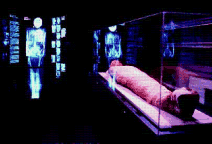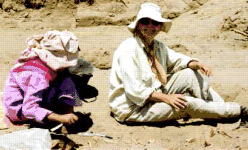


|

|

Approximately 2,300-year-old scribe or priest - male 25-30 years old at death |
In Egypt, University of Alberta, physical anthropologist Dr. Nancy Lovell receives a police escort when she goes to the local market to get groceries. Lovell and her colleagues have 30 soldiers guarding them and their dig site north of Cairo. "...Because of the problems of terrorist attacks on foreigners in Egypt, the Egyptian government provides us at our site with 24-hour armed guards," says Lovell.
Lovell studies human skeletons at archeological sites. "My research area primarily is diseases in antiquity. Rarely can we say what killed somebody, [but] we can say what illness they had." She explains that most people die suddenly and therefore there is little evidence left in the body.

|
She has a real passion for her work. "You get a sense of the equality of human kind -- death is inevitable -- it's a great leveler. I can look at the skeletal remains of someone who lived 5,000 years ago and I can tell you how old they were when they died. I can tell you whether they were male or female," says Lovell with a sense of satisfaction.
Cancer and osteoporosis are of greatest interest to her. "[Cancer] is a big problem right now and yet there are a number of people who believe that many cancers are environmentally induced," she says.
If Lovell can figure out the environment in which cancer and different diseases occurred in antiquity, this information can be used in today's treatments and approaches.

|
Lovell has applied her expertise to the specimens here at the University of Alberta. Our Egyptian mummy, officially donated in 1979, had its first CAT scan about 15 years ago. Before Lovell arrived here at the U of A, it was determined that the mummy had died of cancer, as there appeared to be a tumor on his leg. A more recent CAT scan with '90s technology shows the supposed tumor was actually a gathering of the embalming material and the cause of death is still unknown.
Lovell's study of diseases in antiquity takes her to exotic locations around the world. ".I was in Calcutta in 1984 and at my hotel they told me not to go jogging before 8:30 in the morning because they hadn't picked the bodies up off the street yet," she says.
This marathon runner takes what most would consider a frightening adventure in stride. "There is the everyday thing like the fact that we have cobras nesting in our site and you have to be careful where you sit down, where you walk and that kind of thing. Probably sunburn is a greater risk than being bitten by a poisonous snake but we do have cobras and vipers in Egypt on the site... and scorpions," says Lovell.
When Lovell leaves her lab and Edmonton for a locale like Egypt, Syria or Pakistan she says, "Everybody always says have a nice holiday," but she wants to reply 'it's no holiday.' "You are up at 5 o'clock in the morning and probably go to bed at about 11 -- it depends on whether you have electricity or not. We work six days a week.... You're out there in the dirt and fleas."
In addition to this adventure in the field, Lovell has another passion and that is passing her knowledge on to her students and colleagues.
Back at the University of Alberta, she is the curator of two collections: the osteology collection and the faunal reference collection -- contemporary animal bone reference." ...We have probably one of the most extensive teaching collections in North America," says Lovell. The collection captures much of the intrigue of the field -- without those nasty scorpions.
![[Folio]](http://www.ualberta.ca/~publicas/folio/gif/small/folio.gif)
Folio front page |
![[Office of Public Affairs]](http://www.ualberta.ca/~publicas/gif/small/opahome.gif)
Office of Public Affairs |
![[University of Alberta]](http://www.ualberta.ca/~publicas/gif/small/uahome.gif)
University of Alberta |